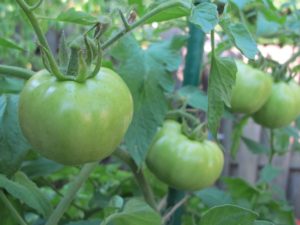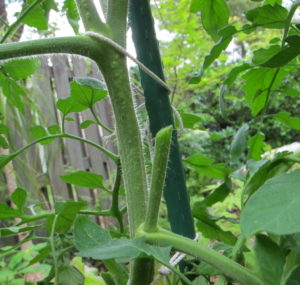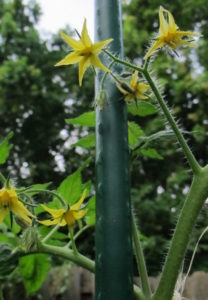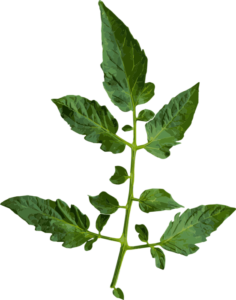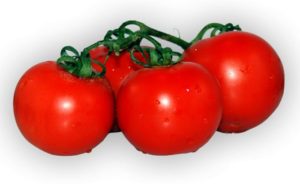2018
How Are the Tomatoes Doing?
The recent stretch of warm, sunny weather has helped the tomatoes and peppers double in height. It’s time to secure them to stakes or to cage them if you haven’t already done so. Once the last of the broccoli side shoots have been harvested from our garden, a zucchini will go there. And cucumber ‘Diva’ will be planted after the cauliflower has been picked, but that’s a while off.
Check with your local Master Gardeners office to see what else is safe to plant now, or look online for a handy planting schedule available from your local agricultural extension office. Keep in mind, though, that these are only guidelines. Weather trends and microclimates will dictate what’s safe to plant.
And Peppers?
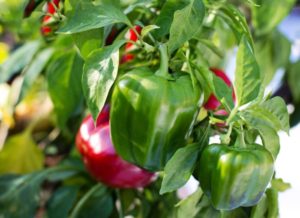
Sweet bell pepper.
Since the varieties of peppers that I planted don’t grow taller than 3′, the tomato cages will be used to support them. The metal cages are only about 3′ tall, once the prongs are anchored into the ground. These short cages are useless for tall tomatoes.
Peppers and tomatoes are in the same family (Solanaceae), by the way, so they need many of the same growing conditions.
As the plants grow, steer the young side shoots through the openings. A sweet bell pepper loaded with 5″ fruits will appreciate the extra support for the limbs. A high wind or a pelting rainstorm can cause heavy branches to split from the main stem. Small-fruited pepper plants can be staked, caged, or allowed to grow without support.
Keep an eye on the weather, though. A forecast calling for windy conditions might prompt you to put something in place before the storm arrives.
Determinate Or Indeterminate Tomatoes
Tomato varieties are categorized as either determinate or indeterminate. This pertains to their habit of growth and when they set fruit.
Determinate tomatoes generally stay short and set fruit within a concentrated period of time. Varieties such as ‘Roma’, ‘Celebrity’, and ‘Patio’ permit the grower to harvest most of the fruits at once—good for canning or making sauce. Although determinates tend to be short, some varieties will grow quite vigorously and might require staking.
Indeterminate tomatoes, such as ‘Big Beef’, ‘Sun Gold’, ‘Nepal’, and ‘Cherokee Purple’, continue growing throughout the season, and often produce right up to frost.
Even though both the cherry tomato ‘Sun Gold’ and the heirloom ‘Cherokee Purple’ are indeterminate tomatoes, the latter may grow to only 5′, whereas ‘Sun Gold’ can grow twice as tall. Learning about the different varieties you want to grow will indicate what kind of staking or caging you’ll have to do. You can always add a taller stake later, if needed.
Staking
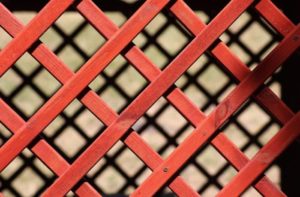
Because we grow indeterminate tomatoes, we use 7′ or 8′ tall vinyl-covered metal stakes. Oak or bamboo stakes are available, as are collapsible wire cages. A decorative trellis is both attractive and functional. Anchor the supports far enough into the ground to prevent them from falling over.
Shoe laces make perfect ties for tomato plants. They’re soft and they can be retied as the stems grow in girth. You can also use twine, twist-ems, clothesline, or anything else that won’t cut into the stem. Some gardeners use ties in a figure-8 fashion, around the stake and around the stem. Or simply loop it once or twice around the stem and stake.
Check frequently through the summer to make sure the stem isn’t being constricted by the ties. Don’t tie so tightly that there is no room for movement or growth. Some bending and swaying in the breeze strengthens the plants.
Staking elevates foliage off the moist soil, decreasing the likelihood of disease.
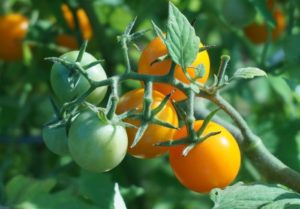
‘Sun Gold’ cherry tomatoes.
Young Plants
Consider the balance between the amount of foliage and the number of fruits. A young tomato plant with only a few leaves will not be able to support ripening fruits. It could show early symptoms of nutrient deficiency.
Examine the newest growth at the top of the plant. The tip growth of a very young plant might show signs of withering, or turn tan in color, or simply refuse to grow if it is also trying to supply nutrients to ripening fruit. Boron, a micronutrient needed in tiny amounts, is critical for new growth. The growth tip will sacrifice itself and future growth in order to do what a plant wants to do, which is to set seed in its fruits.
It’s best to remove all fruits on a very young plant. A sparsely-leaved plant struggles to get enough carbohydrates (the products of photosynthesis) into the fruits. This contributes to slow growth and mediocre flavor.
Suckers
As the tomato plants grow, add more ties, every foot or so, to prevent the tops from flopping over. At the same time, take a look at the stems, and decide which suckers will have to be pruned. Don’t confuse the suckers with the flower stalks that arise from the stems. The flowers are yellow and quite conspicuous.
- Tomato sucker removed.
- Tomato flowers.
Some more basic terminology: A sucker is the common name for the new shoot emerging from the angle between the top of a leafstalk (the petiole) and the stem (photo, above left). The side branch starts out as an axillary bud and grows rapidly. There are axillary buds above most leaves, and the branches, too, will sprout even more suckers. So, you see why it’s important to inspect your tomato vines frequently.
Suckers that are not removed will soon become main stems. The main reason I sucker tomatoes is for increased air circulation. This helps prevent many kinds of diseases from infecting the plants in this humid area. Many gardeners have commented that limiting the number of stems results in fewer, but larger, fruits.
Also, tomatoes will develop better color and flavor, and contain more antioxidants, if they’re exposed to gentle rays of the sun. This is especially true for the “black” tomatoes, such as ‘Black Krim’, ‘Kakao’, and ‘Cherokee Purple’.
A few more terms for you: The tomato leaf is a compound leaf, composed of the petiole and several leaflets, attached by petiolules. And the main rib of the leaf is called a rachis.
How Many Main Stems?
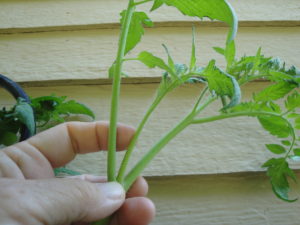
Index finger points to a sucker.
Tomatoes are weedy plants and will grow lots of side branches. For most of the growing season, I keep only 3 or 4 main stems growing on each plant. Near the end of the season, I’m less particular about controlling growth. By then, I’m thrilled to harvest anything off the vines.
Since each of those side branches will try to grow, any suckers that I don’t want to grow into main stems will be removed.
Limiting the growth of foliage encourages better air circulation, helping prevent diseases from ruining your crop. Some growers permit only 1 or 2 stems to grow, but I don’t believe enough products of photosynthesis get to the ripening tomatoes. Just a hunch.
The plant has one thing on its mind, and that is to procreate! In order to do that—well, yes, after pollination—the fruits have to be adequately nourished until the seeds mature. And since all nourishment comes from photosynthesis, the plant needs to have enough leaf surface, and enough direct sunlight, to carry out this vital function.
Can I Root Those Suckers?
If, in early summer, you wish you had planted more tomatoes, you can root healthy 4″ to 5″ long suckers. They root quickly in 3″ or 4″ pots of moist soil, kept humid and in light shade. Simply bury the whole stem in each pot, keeping only a couple of leaves above the soil surface. You can also root them directly into the garden, kept moist and shaded until roots become established.
If it wilts all the time, remove a leaf or two from the bottom of the stem, or cut large leaves in half. A big, leafy cutting won’t be able to root or absorb water fast enough to keep the leaves turgid. Make sure the cutting has good contact with moist soil. Perhaps rooting cuttings in a glass of water will work better for you.
When the cuttings start growing, gradually introduce them to more sun before they’re finally planted out. Tomato suckers root fast, so if you don’t see results within 10 days, start new ones.
The sucker is genetically identical to the parent plant, so the fruits will be the same. This applies to both heirlooms and hybrids.
Limb It Up
Since the first suckers will appear near the bottom of the plant, you might be inclined to let them develop as Main Stem #2 and Main Stem #3. Always keep disease prevention in mind when dealing with tomatoes. I prefer to snip out those bottom suckers and, instead, let the plant start branching 10″ or 12″ above ground level.
As the stem grows taller, remove the bottom leaves, too. That’s right; this permits free air flow underneath the plant. And the soil surface will dry faster, further decreasing the incidence of disease.
Headings
Page 1: How Are the Tomatoes Doing?, And Peppers?, Determinate Or Indeterminate Tomatoes, Staking, Young Plants, Suckers (How Many Main Stems?, Can I Root Those Suckers?), and Limb It Up
Page 2: Sun Scald, Blossom End Rot: Tomatoes and Peppers, Watering Tomatoes, Deer, and They’re Weeds, After All!
